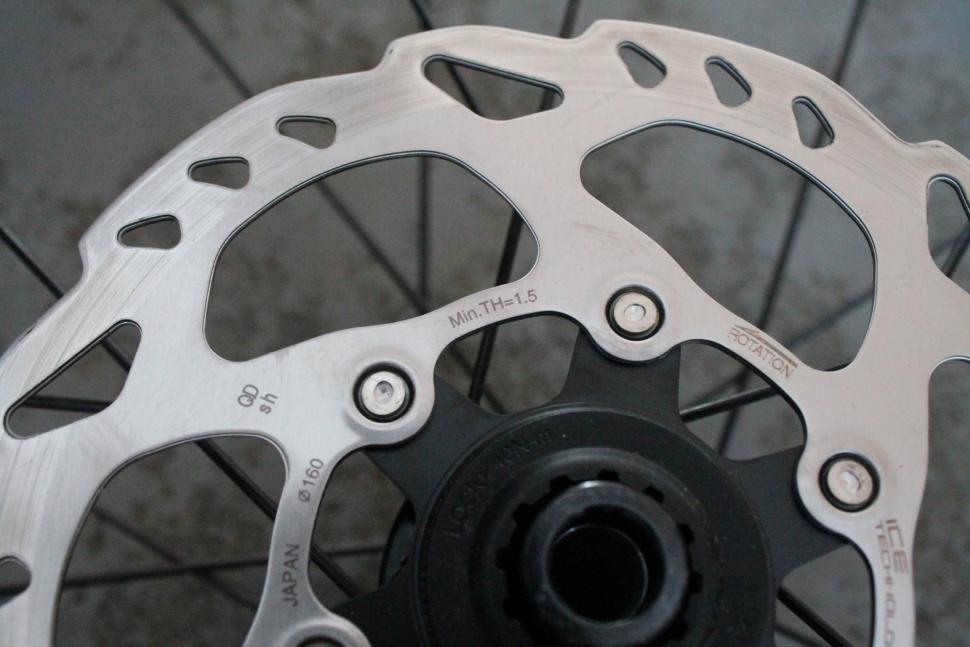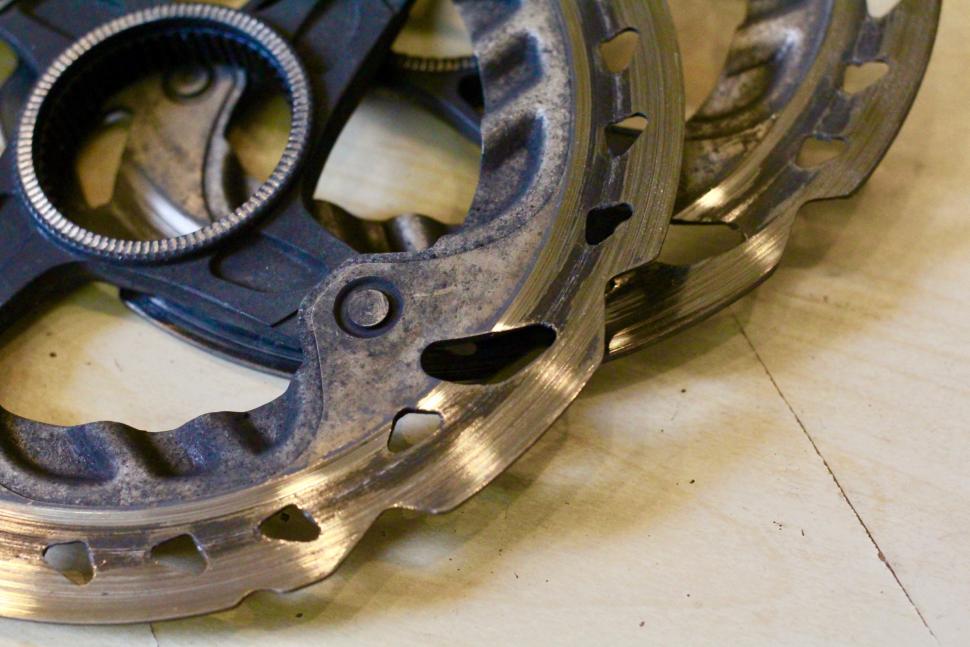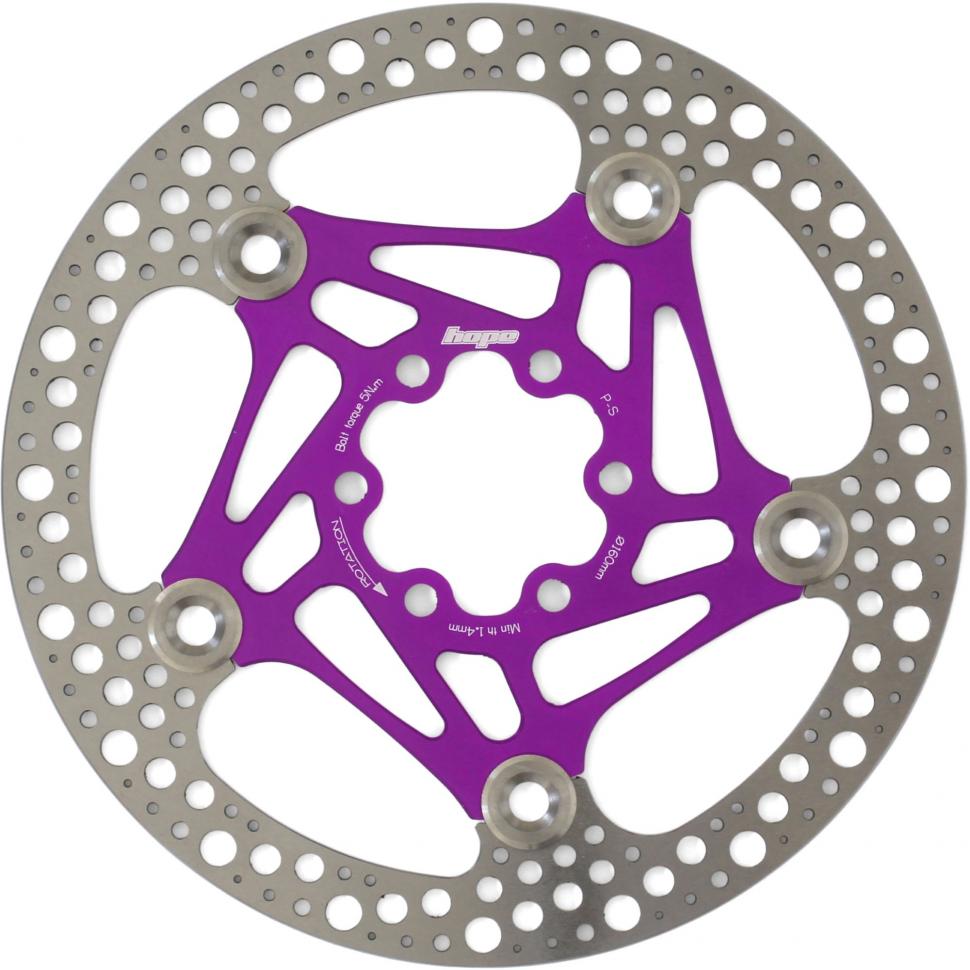- News
- Reviews
- Bikes
- Components
- Bar tape & grips
- Bottom brackets
- Brake & gear cables
- Brake & STI levers
- Brake pads & spares
- Brakes
- Cassettes & freewheels
- Chains
- Chainsets & chainrings
- Derailleurs - front
- Derailleurs - rear
- Forks
- Gear levers & shifters
- Groupsets
- Handlebars & extensions
- Headsets
- Hubs
- Inner tubes
- Pedals
- Quick releases & skewers
- Saddles
- Seatposts
- Stems
- Wheels
- Tyres
- Tubeless valves
- Accessories
- Accessories - misc
- Computer mounts
- Bags
- Bar ends
- Bike bags & cases
- Bottle cages
- Bottles
- Cameras
- Car racks
- Child seats
- Computers
- Glasses
- GPS units
- Helmets
- Lights - front
- Lights - rear
- Lights - sets
- Locks
- Mirrors
- Mudguards
- Racks
- Pumps & CO2 inflators
- Puncture kits
- Reflectives
- Smart watches
- Stands and racks
- Trailers
- Clothing
- Health, fitness and nutrition
- Tools and workshop
- Miscellaneous
- Buyers Guides
- Features
- Forum
- Recommends
- Podcast
feature
 Shimano rotor - 1
Shimano rotor - 1When should you get new disc brake rotors?
One of the benefits of running disc brakes is that there's no wear to your wheel rims when you brake, but the disc brake rotors will gradually wear with use. Thankfully, they tend to have a long lifetime and are relatively cheap and easy to swap.
Worn out disc rotors
Disc brake rotors usually last so long that many people treat them as 'fit and forget' components. However, manufacturers provide minimum thicknesses for their rotors. Shimano recommends that its rotors, which start out 1.8mm thick, should be replaced when the braking surface has been reduced to 1.5mm. This information is given on the rotor; it says "Min.TH=1.5".
SRAM rotors are usually 1.85mm thick to start with, although some of its 140mm rotors are 1.9mm, and they should be retired once they get down to 1.55mm.
Different brands recommend different minimum thicknesses so check the details for the rotors you use. If you could slice ham with yours you've left it waaay too long!
If a small step has developed between the braking surface and the rest of the rotor, that's an indication that it could need changing, but we'd recommend measuring the thickness properly. The easiest way is with a micrometer, vernier calliper or a digital calliper.
Something like the Park Tool DC-1 digital calliper (below, £49.99) is perfect for the job.
It isn't possible to give an estimated mileage for a disc rotor because wear will vary according to the type of rotor used, the pads applied to it, rider weight and braking habits, the terrain ridden, typical conditions, the cleaning regime, and many more factors.
Don't be tempted to continue using rotors beyond their minimum thickness. These are safety items, after all, and it's not worth the risk.
Bent disc rotors
Another reason to replace a disc brake rotor is if it is badly bent.
Disc rotors can bend if they get too hot, are damaged in a crash or if too much pressure is applied to the side, frequently during travel. Putting a bike in the back of your car and resting something on the rotor is quite a common cause.
Sometimes you'll clearly see that a rotor is bent, and other times you'll realise when one part rubs on the brake pads as the wheel turns.
Find out everything you need to know about disc brakes
If a rotor is badly bent, you should replace it, especially if it was caused by crashing. In other circumstances, you might as well try to straighten the rotor. It's not rocket science and you have nothing to lose. Use a rotor truing tool like the Park Tool DT-2 (£19.99) or the jaws of an adjustable spanner to bend the rotor back into shape.
The easiest way to do this is with the wheel still on your bike. You simply find the section of the rotor that's bent – either by eye or by passing it through the brake calliper and listening for rubbing – and push it back in the opposite direction, being careful not to overdo it.
Upgrading disc brake rotors
You might simply want to replace your disc brake rotors because you fancy an upgrade.
Cheaper rotors are one piece, cut from steel, while floating rotors are more expensive. This is where the central carrier is aluminium with the braking surface made from steel. The idea is that you get consistent performance even if your braking system heats up during use. Ones from Hope (above) are priced £50.
Shimano incorporates what it calls Ice-Tech in many of its rotors, using a three-layer sandwich structure of stainless steel and aluminium, the aluminium included because it transfers heat better than steel. Reduced heat in the braking system reduces brake fade (a fall-off in performance on long descents). It also increases pad life and can lead to quieter braking.
Here's how to look after disc brakes and get the best performance out of them
Shimano's SM-RT99 rotors have 'fins' inboard of the brake track designed to maximise surface area for improved cooling. Shimano says that the increased surface area leads to a reduction in heat and a consequent increase in braking force.
Changing rotor size
You'll usually want to replace a disc brake rotor with one of the same size, although a different size can make sense in some circumstances (assuming your bike can support this and you have the correct adaptors). All other things being equal, a large rotor will slow you down faster than a small rotor.
Here's how to fit new disc brake rotors
Shimano's road disc brake system has been designed for use with 140mm or 160mm rotors, the idea being that users can choose the size to suit their weight and intended use.
SRAM’s Paul Kantor said, “We recommend 160mm rotors front and rear for road use and 140mm is fine for cyclocross. We have tested 140s extensively but we like the margin of safety that 160s offer for the road.”
Focus has told us that in testing it found 160mm rotors preferable to the more common 140mm, handling the buildup of heat more effectively. This goes against the trend for smaller rotors on the road.
The choice is yours but if you’re a larger rider you might want to start with 160s and see how you go.
Buying new rotors
There are two different disc rotor and hub standards: 6-bolt (see the Hope rotor pictured higher up the page) and Centerlock (see the Shimano rotors pictured above). The difference is self-explanatory: a 6-bolt disc rotor is fixed to the hub with – you guessed it – six bolts while the Centerlock system uses a lockring.
You can get adaptors, but make things simple for yourself by just swapping like for like.
Mat has been in cycling media since 1996, on titles including BikeRadar, Total Bike, Total Mountain Bike, What Mountain Bike and Mountain Biking UK, and he has been editor of 220 Triathlon and Cycling Plus. Mat has been road.cc technical editor for over a decade, testing bikes, fettling the latest kit, and trying out the most up-to-the-minute clothing. He has won his category in Ironman UK 70.3 and finished on the podium in both marathons he has run. Mat is a Cambridge graduate who did a post-grad in magazine journalism, and he is a winner of the Cycling Media Award for Specialist Online Writer. Now over 50, he's riding road and gravel bikes most days for fun and fitness rather than training for competitions.
Latest Comments
- Hirsute 1 hour 7 min ago
"We pay our road tax" ! Handy to know if I go there that there will be spaces in the car parks !
- Tom_77 1 hour 8 min ago
Olympic gold medallist would remove name from cycle path if quarry plans go ahead...
- brooksby 1 hour 11 min ago
I think its in the Book of Job: one of the (many) torments with which Job was tested, was having double yellow lines and a cycle lane painted...
- SecretSam 1 hour 32 min ago
The LEDs always were rubbish, TBH (v1 Bolt user)
- Owd Big 'Ead 1 hour 58 min ago
Condolences to the family. What a tragedy.
- OnYerBike 3 hours 23 sec ago
@Sredlums: I'm not sure I follow your logic. If someone grabs your helmet twists it, then the reason it doesn't feel good is because the outer is...
- Rapha Nadal 3 hours 34 sec ago
Coming to the mid-paced Saturday club ride soon.
- Secret_squirrel 3 hours 56 min ago
Interesting review. I have the Bont MTB+ and they are the most comfy cycling shoes I have ever worn. I use them with a Superfeet Green Insole...
- Miller 4 hours 2 min ago
I have a few thousand km on a bike with the Ltwoo group so I'll be interested to see that reviewed.
- brooksby 4 hours 4 min ago
It really feels like we're living in some sort of SF dystopian novel, doesn't it?






Add new comment
24 comments
Has anyone found Centerlock to be less prone to squealing when wet? Or can recommend any discs that are? My only complaint with mine is the squealing, and I have a Hunt wheelset that came with 6-hole discs and a Centerlock to h-hole adapter. Wondering if I would get anything other than a little weight savings from losing the adapter.
Not in my experience.
I've tried a few variations of rotor design, skeletal wavey designs (Magura Storm), beefy 2mm thick 'low noise' e-bike rotors (Magura again), shimano centrelock, shimano six bolt, Swissstop centre lock (also marketed as low noise).
They're all much of a muchness and all squeal terribly when they get wet.
I've since gone back to rim brakes on all but my MTB, but noticed that the MTB (Swissstop yellow pads, XT six bolt rotors) is now virtually silent in all conditions. I think they are the only pads that I have properly bedded in thanks to several very long, rocky Cairngorm descents, the likes of which I never subject my road or gravel bike to.
So if I ever go back to discs on my road or gravel bike I'll bed them in first on the MTB! And bed them in again after a few months as I think road and gravel braking isn't very good for rotors, I think they need proper hard braking and lots of heat periodically.
Think there is a correction needed about floating rotor's. Its not the fact that the carrier and rotor are different material its that they are connected in a way that allows the rotor to move in relation to the carrier. See the big mountings in the Hope picture.
Ah the old rotor thickness question.....then as has been said.... Resin only rotors....Shimano...we tend to fit rotors which can take all pad types rather than stock ones. Biggest issue we get is squeal...but that is another story
I believe squeal is a known issue with resin discs - commonly caused by scratching.
The answer currently is:
"Whenever anyone has stock"
on a different tact, when did the big round part of disc brakes become a Rotor as opposed to a Disc
A quick check of Google Ngram viewer shows "brake disc" about twice as common as "brake rotor" overall, but is six times as common in British English, and only about 1.5 times as common in American English. Definitely in the US if I've wanted that part for my car any time in the last few decades, I've been able to ask for "rotors."
"Wing mirror" is 16 times more common than "door mirror", though.
Probably around the same time that a derailleur became a "mech", *sigh*.
That one I can state is not an Americanism. They're still called derailleurs here, and even spelled that way, despite the late great Sheldon Brown's (and Grant Petersen's?) campaign for "derailer".
https://www.sheldonbrown.com/derailer.html
you can get digital calipers for at lot less than park tools -think i paid about £20 for mine. they are incredibly useful. seat post diameters, stem lengths, rotor diameters, any other measurements. Especially rim internal widths if you are trying to get the air stay in a tubeless set up. recommended
The Park micrometer looks identical to those on EBay at a fraction of the price.
wait - some of you seem to be complaining of problems with disc brakes, including wear and tear issues. Can this be true?
Turns out if you use non-resin pads on resin-only rotors you can wear a pretty good lip into them.
I've never heard of resin-only rotors - what are they made out of?
Edit: just googled and found out that it's mainly lower end rotors that don't have the same heat treatment/hardening. Seems like they can easily warp as they don't handle heat very well.
A different grade of metal. Cheaper discs are resin only, you generally have to pay more for ones compatible with sintered pads. Shimano RT-54 is resin-only, for example.
Didn't even know it was a "thing".
Does anyone know if floating disks might make things a little quieter?
Floating disks don't make things any quieter really. Might have reduced the high temp scream, maybe.
Looks so cool though. I wanted something slightly bigger and the old one was worn.
I hadn't either until I started wondering how they'd got worn so quickly!
Once the pad is down to the metal I find that resin and sintered are on a par for disc wear...
When buying new rotors, get the least "wavy" ones with the smallest holes you can.
The Hope and Shimano ones in this article are ideal.
I've got one bike that came with Hayes rotors with a very wavy edge - they look great, but the braking is terrible and "pulses" at low speeds as the pads rock over the narrow parts of the disk, which also chews the pads up.
I've also seen some disks that are more hole than disk and must chew up pads - especially softer organic ones.
It's the same in the car world - cross-drilled and drilled discs did little for road performance but looked cool and really only helped EBC sell more pads
When I was a bike mechanic, I had one customer who wanted his pads replaced. I released the cable and was confused when the wheel didn't drop out. The disc was so worn that I had to disconnect the cable completely to get it past the pads, and it must have been less then 1mm on the inside track. I told him that his discs had to be replaced immediately otherwise they would fail catastrophically, and he said he'd think about it, and would call me back; he didn't. I hope he's still in one piece.
Anticipating the shutdown I decided to source as much of the consumables that I might need for the new Ultimate Commuter, and in that assortment were a couple of sets of disk brake pads, glad I did as it would seem that within a couple of weeks I really needed them. The rears, which are very easy to see still have plenty of meat on them, but the fronts were almost gone. I noticed they had started moaning a bit in use, nice to know there are signs. Never happened with my many rim brakes, that the front wear far quicker than the rear, could be the larger disk on the front had someting to do with it, 160mm on the back 180mm on the front, or I might be using it more, who knows.
I tended to get through 2 rims on the rear to 1 on the front, and sort of similar to brake blocks, and indeed adjustments on the pads on the cantilevers.
I'm glad I decided to get the Park PP-1 as pushing the pads and pistons wider was not as easy as I might have liked.
Pushing the pistons back when replacing the pads - I always leave the old pads in, and push them apart with a flat screwdriver. That pushes the pistons in. It chews the remaining pad surface, but your next step is to bin them.